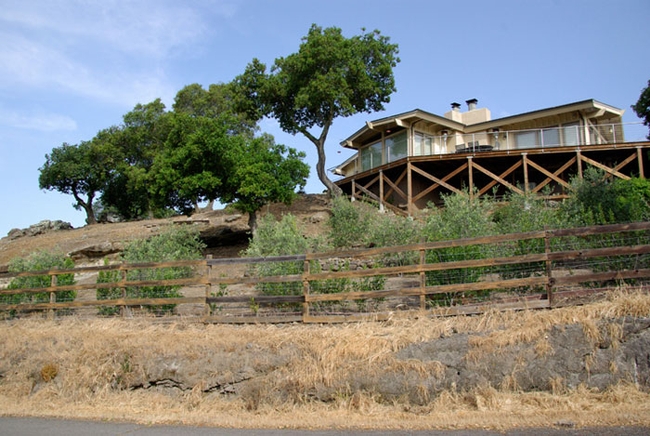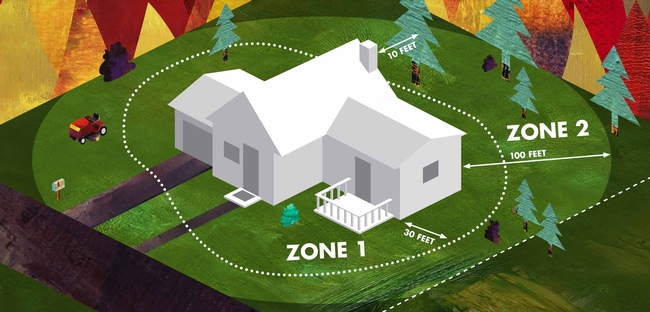Even when homeowners have created a defensible space, the job of protecting their home from fire is never done. There will always be ongoing and annual jobs to do. Additionally, there are special tasks that will need to be completed every few years or on an as needed basis.
A key ongoing yard maintenance goal is to keep plants green and lush, especially within the 30 feet closest to the home (the “home ignition zone”). Of course this means regular watering, which can be time consuming, but employing a drip irrigation system on a timer largely eliminates that concern. Using appropriate native plants should cut down on the overall need for watering as well.
The ground in the inner 30 feet around a home should also be kept free of leaves, pine needles, weeds and other ground fuels. Dead plants and/or tree branches should be immediately removed, as should any tree branches overhanging the roof. Tree branches should also be kept at least 10 feet away from a chimney. Vines growing on trees, shrubs, or fences can act as fire ladders and should be removed. Roofs and gutters should be kept free of leaves, needles and twigs. Gutter covers can reduce, if not eliminate, fuel build-up in this area.
If raised decks or porches are present, prevent combustible materials from accumulating in the areas beneath them. A preferable alternative to continually raking under decks and porches is to screen or enclose them with fire-resistant materials. If screening is used, the mesh should be no greater than one-quarter-inch. Flammable materials should be cleared from decks. This includes not only natural materials like leaves and needles, but items such as brooms and stacked wood.
Annually, before fire season starts, grasses and weeds should be mowed to a height of about three to four inches for at least 30 feet around homes and other structures. Grasses and weeds should be maintained at this height throughout the fire season. In fact, ground fuels should be kept at a minimum throughout the defensible space. As an alternative to mowing, string trimmers are a safer option for vegetation removal. To reduce the risk of fire due to mowing, make sure your equipment is properly maintained, mow before 10 a.m. and never mow on a hot or windy day.

Vegetation throughout the defensible space should be pruned for proper spacing, both vertically and horizontally, at least once per year. Cal Fire recommends that the lower branches of a mature tree be pruned to create a clearance of three times the height of the shrubs beneath it, while the distance between shrubs should be at least twice the height of the shrubs. In addition to maintaining proper spacing, pruning also makes plants more fire resistant. Cutting back woody perennials encourages less flammable new growth and thinning overgrown shrubs reduces their fuel load. Avoid topping landscape trees. Topping not only increases the fire hazard by encouraging excessive branching, but it is not healthy for trees.
Woodpiles should be located at least 30 feet from a home and should have at least 10 feet of cleared space around them. Covering a woodpile, or storing wood in a fire-resistant structure such as a metal shed, lowers the odds of the pile igniting during a wildfire. In addition, miscellaneous combustible materials including construction debris and brush piles should be removed from your yard as quickly as possible.
To aid firefighters, be sure your address is clearly posted so that it is easily visible from the street, especially at night. Also, be certain firefighters have easy access to water sources in your yard and, if possible, clearly mark those water sources. Fires often lead to power outages, so if you are on a well, it would be prudent to have an emergency generator to operate the pump if the power does fail.
Cal Fire has developed a “Homeowners Checklist” that describes how to make your home fire safe. It is an excellent, easy-to-use, comprehensive guide for homeowners. It is highly recommended. For more information on creating fire-resistant landscapes, see the Firewise Landscape section of the UC Master Gardeners of Butte County website. Other helpful sources include Yard Maintenance by UC Master Gardeners of Sonoma County and defensible space tips by the Butte County Fire Safe Council.
UC Master Gardeners of Butte County are part of the University of California Cooperative Extension (UCCE) system. To learn more about us and our upcoming events, and for help with gardening in our area, visit our website. If you have a gardening question or problem, email the Hotline at mgbutte@ucanr.edu (preferred) or call (530) 538-7201.
